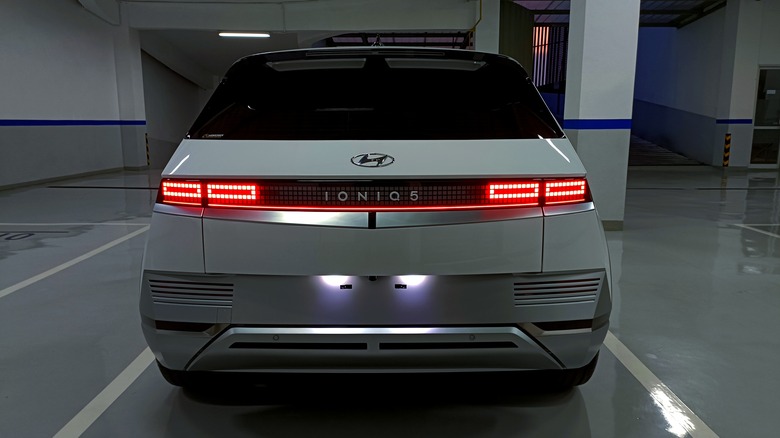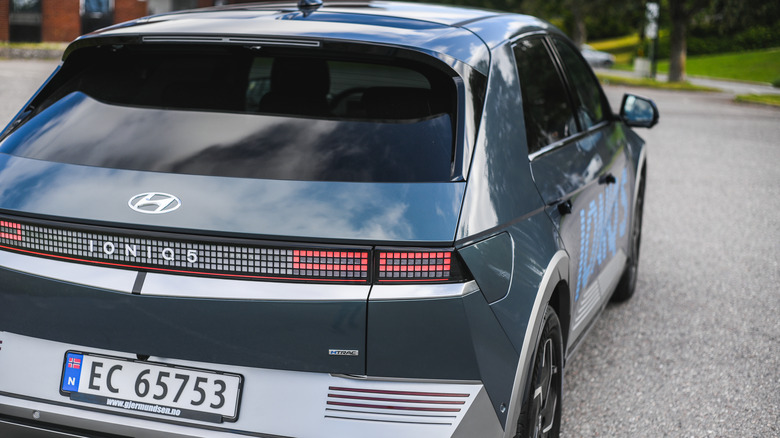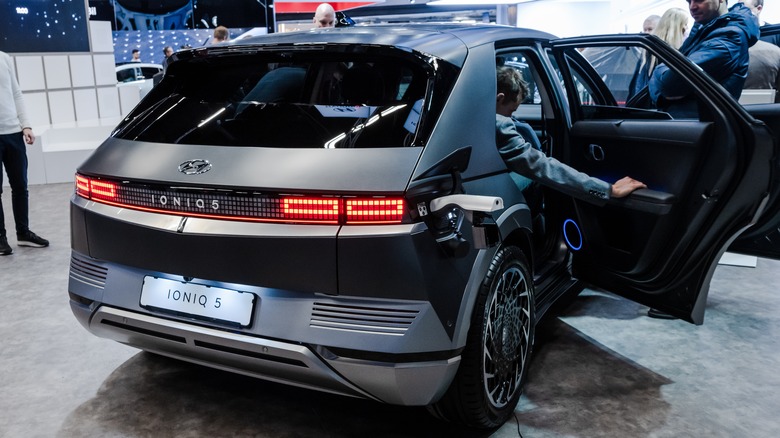The Hyundai Ioniq 5 Needs To Rethink Its Brake Lights Before It Causes An Accident
As complex as cars are, brake lights are one part that everyone easily understands — you hit the pedal, and the brake lights come on. This alerts drivers behind you that you are slowing down and that they should do the same to avoid a collision. Brake lights are one of the most basic elements of vehicular safety equipment and are crucial to keeping you and those around you safe. This is why brake lights are usually well-regulated and why you can be ticketed if your brake lights are not functioning properly.
With the proliferation of electric vehicles, or to be more accurate, regenerative braking, automakers have had to reassess their brake light setups to make sure that they work with both conventional brakes and regenerative brakes. Enough time has passed that most automakers have figured out how to integrate these systems so that their brake lights function as expected.
That being said, the Hyundai Ioniq 5 has been found to have a glaring flaw — as Youtuber Technology Connections has discovered, its brake lights don't always turn on under regenerative braking.
How do brake light systems usually work?
Traditional braking systems have a switch behind the brake pedal, activated when the driver pushes the brake. This causes the brake lights to turn on as the friction brakes at each wheel are activated. As simple as this system may be, the introduction of regenerative braking as seen in hybrids and EVs adds complexity.
In a regenerative braking system, the vehicle's electric motor is used as a generator and provides a braking force before the friction brakes kick in. Like engine braking, using the vehicle's kinetic energy to spin the electric motor and generate electricity slows the vehicle down. In a conventional regen system, the intensity of the braking force is decided by the amount of pressure applied to the brake pedal. Beyond a certain threshold, the friction brakes are also activated, but since the brake pedal controls both systems, the brake lights will turn on regardless of which system is slowing the vehicle down.
In one-pedal driving, as seen in some EVs, the brake pedal is no longer needed to slow the vehicle down significantly, even to a complete stop, as the vehicle uses powerful regenerative braking combined with automatic actuation of the brakes. Therefore, the switch which controls the brake lights isn't activated. Automakers usually program their EVs to activate the brake lights when slowing significantly due to this regenerative braking, even though the switch at the brake pedal hasn't been activated.
What's wrong with the Ioniq 5?
The Ioniq 5's brake lights seem to work fine under most circumstances, except for under i-Pedal mode, which is Hyundai, Genesis, and Kia's name for their one-pedal driving mode. When in i-Pedal, the Ioniq 5's regenerative braking system is set to its highest power, delivering the greatest amount of braking force and power regeneration. This braking force is distributed across a portion of the accelerator pedal's travel, with that force increasing the more you release the accelerator. In other words, when you reduce the pressure on the accelerator but still keep your foot on it, the vehicle slows down under regenerative braking, but not with the same intensity as it does when you lift your foot off the accelerator entirely.
Herein lies the problem. As Technology Connections outlines in the video embedded above, it turns out that the Ioniq 5's brake lights are programmed to be illuminated only when the driver's foot is entirely off the accelerator, and they do not turn on if even the slightest amount of input is given to the pedal. So when in i-Pedal mode, the Ioniq 5's brake lights will turn on when its regenerative braking is at 100%, but not at 99%. Since i-Pedal sets regenerative braking to its highest setting, it can impart significant braking force before the pedal is released completely.
In fact, the Ioniq 5 has been recorded decelerating from 60 to 0mph without its brake lights illuminating because it was in i-Pedal mode.
What's the solution?
The immediate solution to this Ioniq 5-specific issue is likely an immediate recall and software update. This update would have to change the conditions under which the brake lights illuminate to include instances of regenerative braking.
In the long term, regulations also need to be put in place to make sure other automakers aren't able to make the same mistake, and the most straightforward parameter to base it on would be deceleration, as opposed to the pedal position. While U.S. regulations allow for this issue to exist, formulating new regulations to fix it shouldn't be very difficult because it has already been done elsewhere in the world.
The European Union has already implemented a regulation that mandates that brake lights must be illuminated when regenerative braking causes a vehicle to slow down by more than 1.3m/s2. It still leaves automakers with the choice of whether to activate the brake lights when the vehicle is decelerating by more than 0.7m/s2 and up to 1.3m/s2, but makes sure that the lights come on during significant braking, ensuring they fulfill the primary goal: alerting other drivers that you are slowing down significantly.


